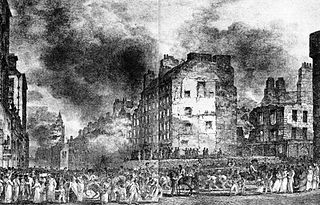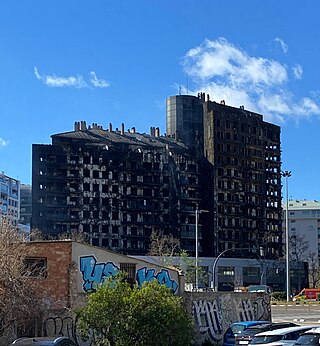
The Great Fire of 8 July 1892 in St. John's, Newfoundland and Labrador is remembered as the worst disaster ever to befall that city. Previous "Great Fires" had occurred in St. John's, during 1819 and 1846.

The Bukit Ho Swee fire was a conflagration that broke out in the squatter settlement of Bukit Ho Swee, Singapore on 25 May 1961. This fire resulted in 4 deaths and injured another 54. It also destroyed more than 2,800 houses around the Bukit Ho Swee area, leaving around 16,000 people homeless. The cause of this conflagration was never established. The Bukit Ho Swee fire was the biggest outbreak of fire in Singapore's history.

The London Fire Brigade (LFB) is the fire and rescue service for London, the capital of the United Kingdom. It was formed by the Metropolitan Fire Brigade Act 1865, under the leadership of superintendent Eyre Massey Shaw. It has 5,992 staff, including 5,096 operational firefighters and officers based at 102 fire stations.
The Hull-Ottawa fire of 1900 was a devastating fire in 1900 that destroyed much of Hull, Quebec, and large portions of Ottawa, Ontario.

The history of organized firefighting began in ancient Rome while under the rule of the first Roman Emperor Augustus. Prior to that, Ctesibius, a Greek citizen of Alexandria, developed the first fire pump in the third century BC, which was later improved upon in a design by Hero of Alexandria in the first century BC.

The 1994 eastern seaboard fires were significant Australian bushfires that occurred in New South Wales, Australia during the bushfire season of 1993–1994. Some 20,000 firefighters were deployed against some 800 fires throughout the state, and along the coast and ranges from Batemans Bay in the south to the Queensland border in the north, including populated areas of the city of Sydney, the Blue Mountains and the Central Coast. The fires caused mass evacuations of many thousands of people, claimed four lives, destroyed some 225 homes and burned out 800,000 hectares of bushland. The firefighting effort raised in response was one of the largest seen in Australian history.

The 2009Table Mountain fire was a large fire in and around the Table Mountain National Park in Cape Town, South Africa. It broke out at approximately 20:30 on 17 March 2009 in the vicinity of Rhodes Memorial and initial fears were that the fire would spread to UCT's Upper Campus. The Table Mountain National Park quickly deployed firefighting personnel on the mountain, but the fire spread due to the strong winds. At around 23:20 on Tuesday evening, the fire started moving up Devil's Peak and by 00:00 was at the tip and making its way around the mountain to the suburbs of Tamboerskloof, Oranjezicht, Vredehoek and Gardens on the north side. The flames were engulfing the mountain and the huge amounts of smoke made it hard for rescue and fire-fighting helicopters making their way to the fire. By 00:30, people from the aforementioned areas were told to evacuate due to the strong winds pushing the fire around the mountain. By this time, Fire & Rescue Services had deployed 29 fire engines and 90 firefighters who were assisted by 45 firefighters from the South African National Parks and volunteers of Disaster Management

The 1943–44 Victorian bushfire season was marked by a series of major bushfires following severe drought conditions in the state of Victoria in Australia. The summer of 1943–44 was the driest summer ever recorded in Melbourne with just 46 mm falling, a third of the average for the period. Between 22 December and 15 February 51 people were killed, 700 injured, and 650 buildings were destroyed across the state. Many personnel who would have been normally available for fire fighting duties had been posted overseas and to remote areas of Australia during World War II.
The 1900 Westchester County tornado was an intense, but short-lived tornado that caused significant damage near the city of New Rochelle, New York.

The Club Cinq-Sept fire was a major blaze at a nightclub just outside Saint-Laurent-du-Pont, Isère, France, on Sunday, 1 November 1970. The fire claimed the lives of 146 people, almost all of whom were aged between 17 and 30. The scale of the disaster shocked the country. Subsequent official enquiries revealed a catalogue of shortcomings, oversights and evasions with regard to fire safety at both local and département level. Criminal charges were brought against a number of people; some received suspended jail sentences.

Stockholm has largely escaped looting and natural disasters, but the city's major scourges have been fires, which in the worst cases have wiped out entire neighborhoods. The population of Stockholm has historically lived in constant fear of the outbreak of fire, because the risk of fires in the 16th- and 17th-century Swedish cities was great. Each citizen remained on night watch well into the 19th century. The worst fire in the history of Stockholm was the fire of Clara in 1751, which evolved into a firestorm spreading from Riddarfjärden to Södermalm.

The McTavish reservoir, named for Simon McTavish, is an underground reservoir and park located beside McGill University's campus on the southern slope of Mount Royal in Montreal, Quebec, Canada. It holds 37 million gallons of water and is supplied by its large Châteauesque style pump-houses situated in the south-eastern corner of the park. Atop the reservoir is Rutherford Park, and it is also the location of the McTavish automated weather reporting station.

The Great New York City Fire of 1845 broke out on July 19, 1845, in Lower Manhattan, New York City. The fire started in a whale oil and candle manufacturing establishment and quickly spread to other wooden structures. It reached a warehouse on Broad Street where combustible saltpeter was stored and caused a massive explosion that spread the fire even farther.

The Great Fire of Edinburgh was one of the most destructive fires in the history of Edinburgh. It started on Monday, 15 November 1824, and lasted for five days, with two major phases.

The Great Chelsea fire of 1973, also known as the second Great Chelsea fire, was a conflagration that occurred on October 14, 1973, in Chelsea, Massachusetts, a city directly across the Chelsea Creek from East Boston. The fire burned 18 acres (7.3 ha), and was spread by strong winds and a lack of adequate water supply in the neighborhood of the fire. The fire started 200 yards (180 m) away from the origin of the Great Chelsea fire of 1908.

The most destructive bushfire season in terms of property loss since the 2008–09 Australian bushfire season, occurred in the summer of 2015–16, with the loss of 408 houses and at least 500 non-residential buildings as a result of wild fires between 1 June 2015 and 31 May 2016. The season also suffered the most human fatalities since the 2008–09 Australian bushfire season; 6 died in Western Australia, 2 in South Australia and 1 in New South Wales. 8 deaths were as a direct result of fire, and a volunteer firefighter died due to unrelated health complications while on duty.

Fire and Emergency New Zealand is New Zealand's main firefighting and emergency services body.
The 2016 Waroona-Yarloop bushfire started in the east in the forests of the Darling Scarp before reaching the Swan Coastal Plain and continued westwards until it reached the Indian Ocean. It started as a lightning strike that caused two fires in the Lane Poole Reserve state forest near Dwellingup, Western Australia on 5 January 2016 and then burnt close to Waroona and then through the historical town of Yarloop, destroying it, before continuing southwards towards the outskirts of the town of Harvey and westwards to Preston Beach. Around 70,000 ha of land was burnt, two people died and at least 166 buildings were destroyed in Yarloop alone with only ninety buildings surviving. In total 181 buildings and structures were lost with the total cost of fighting the fire and the cost of the damage and the loss resulting estimated at $155 million.

On 22 February 2024, at approximately 17:30 CET, a fire broke out in a 14-storey luxury residential complex located in the Campanar district of Valencia, Spain. The rapid spread of the fire, exacerbated by strong winds, building materials and a stack effect, led to the complete destruction of the complex's 138 apartments, trapping numerous residents inside.


















